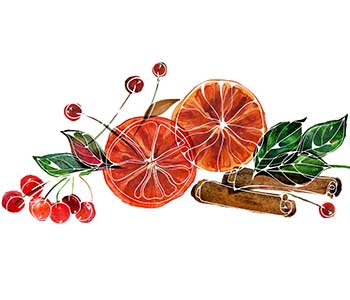
A delightful and unburdened feast!
This should be an inspiration for a relaxed Christmas, with which we burden the environment and ourselves as little as possible. These suggestions include many useful things, some of which are easier to implement than others. The more the merrier, but nobody needs to be perfect. This list is not meant to be exhaustive.
The more we realise, the more we contribute to this climate goal: SDG 12 – Ensure sustainable consumption and production patterns
Dezember 2021
Originally, Advent was also Lent. After St. Martin's Day on 11 November, a 40-day period of abstinence and penance began to prepare for the arrival of Jesus. On Christmas Eve, therefore, only light food was served to accustom the body slowly to heavier food again. Only then did they start eating sweets again, Christmas biscuits. Advent and Christmas have long since lost their religious aspect. Especially on Christmas Eve, the tables are bent; in the days that follow, rubbish collection is in high season and the food thrown away could feed entire cities. During Christmas week, an average of 550 tonnes of residual waste and 300 tonnes of waste paper are generated in Vienna alone. That is about ten percent more waste than usual.
Many traditional things lack critical awareness because they are simply habitual. If you suddenly look behind the scenes, you see the madness. This is the case with the poinsettia, our popular pot plant, see below. A newspaper article drew attention to the fact that there is harmful machinery behind the supposedly harmless plant. And suddenly one sees things with different eyes. So here is a list of what you can do to celebrate the big festival more consciously and sustainably. A glimpse behind.
-
Food 🍤 A shopping list tailored to the menu and the number of guests helps to keep track and avoid buying too much. As always, the rule at Christmas is regional, organic and if meat and fish are bought, then do so carefully. Exceptions prove the rule, but then please enjoy twice as consciously! Freeze what you have bought or cooked too much, or give it to neighbours or charities.
- Fisch 🐟 Fish and seafood fill their own section. The agony of choice is particularly great here. What is allowed and what is not allowed? If you want to find out which fish from which regions are still allowed in the frying pan, take a look at the WWF seafood guide.
-
Drinking 🍷. The common Christmas hangover lurks everywhere. Drinking water helps ... And as with food, the same applies here: local rather than imported. Glass bottles in particular have a huge CO2 footprint during transport. Better a good Blaufränkisch from Burgenland than from Argentina if you live in Austria. It usually tastes better too!
-
Biscuits 🍪. Less is more. A "rationed" number of biscuits helps to enjoy them more consciously and prevents sugar shock. If you bake your own biscuits, you should particularly pay attention to the origin of the eggs. And make sure to choose biscuit varieties that complement each other in the consumption of egg white and egg yolk. If not, the two can be frozen separately and will keep for up to half a year.
- Chocolate 🍫. Chocolate makes people happy. But unfortunately not all. Cocoa farming has a long history of exploiting people and the environment. Rain forests are cleared for plantations, pesticides poison the environment and people, and they are exploited with poor working conditions. Child labour is also still common. Therefore, please pay attention to origin and certification: organic and fairtrade (or UTZ and Rainforest Alliance). Unfortunately, these seals are not the last word in wisdom, but they are better than nothing. That's why chocolate from companies you know is even better. Like from the wonderful Zotter or Perù Puro. Thank you!
-
Wrapping 🧻. Wrapping paper is usually used once and thrown away. If you can wrap without adhesive tape, you can reuse it several times (no-go: foiled or metal-coated paper. It must therefore not be placed in the paper bank, but in the residual waste.). Even better is without. Newspaper or tissue paper that came into the house as protective packaging for new glasses, for example, can look very pretty tied up with hemp yarn or raffia strings. And really clever and pretty are fabrics as wrappings. You can leave them as a gift (e.g. a shawl) or take them with you again, see also the Japanese packaging art Furoshiki. Fabric bags or reusable gift bags also work, of course.
-
Gifts 🎁. If you can't come up with anything clever because the recipient already has everything, you can give the gift of joint activities and save long faces and more rubbish. Now that we are all starved for art and culture, for visits to restaurants and excursions, we will probably have the greatest pleasure. This also applies to children, of course, and here too above all: toys made of wood or other renewable raw materials are better than those made of plastic stuff.
-
Candles 🧨. The better the quality of a candle, the slower it burns down, the less it soots and the fewer pollutants it releases into the air. So cheap candles are definitely saving money in the wrong place. So a tree with cheap candles is definitely saving money in the wrong place. Stearin candles, if not palm oil-based, would be better. Beeswax candles are best, but also expensive. You can find Christmas tree candles from beewax in organic shops. Dear, but the way they burn down slowly, they can be used two or three times. And therefore, in the end, expensive candles are a good investment.
- Fairy lights ✨. If you absolutely have to install some, please use LED lights, otherwise it really is a waste of energy. This applies to indoors and outdoors. Please also think of the neighbours, especially flashing lights can be very disturbing. Lights must be turned off after 10 p.m., because light pollution is also a serious and growing problem. Incessant lighting disturbs ecosystems, is one of the reasons for the loss of insects and also gives us humans sleepless nights.
-
Winter rose 🌺. The beautiful dark red flower pot plants that we all have at home at this time of the year are flowering waste. 80 million of them end up on the rubbish heap in Europe every year, the environmental impact is enormous. Plastic pots and film, cheap soil with peat, water wastage and transport from the south are the biggest environmental sins. The working conditions on site are also mostly questionable. Those who still don't want to do without them can keep them alive for several years with sparing watering and peat-free soil with sand, among other things. And buy organic and fairtrade, if possible.
-
Christmas tree 🎄. A dilemma. It has to be the green fir tree. But even here, not everything is environmentally friendly; in general, herbicides are sprayed under the tree. If you make sure the trees are of good origin, it gets expensive and in the end you are nevertheless left with huge piles of dead trees. If they are processed further, however, they have a zero CO2 balance. Living Christmas trees are a good alternative, and you can now rent them. In Austria e.g. from Greentree, where they are delivered and collected and live on. As always, it is important to find a good supplier so that the tree really survives. And a completely different option: why not simply repurpose and decorate a larger houseplant?
-
Tinsel ⚡️. There used to be more tinsel. That's right! The fine metal foils are a great burden on the environment. Thank goodness no one does that in this country any more. That's it!




